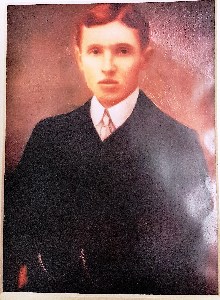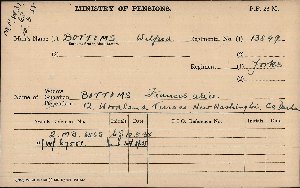
Photo : Linda
Medal Index Card
Military Medal award

Ministry of Pension Card P.F. 23M
Illustrated Chronicle
His parents had married in 1878 in the district of Chester-le-Street and at the time of their marriage his father was a coal miner. His mother Esther Hannah (born 1859, died 1924), came from Nether Poppleton, Yorkshire and his father William (born 1858, died 1915) from South Hetton, Durham. In 1881 they were residing at 55 Washington New Row, Usworth and William was a coal miner by trade.
They had eight children in total – six boys and two girls. Wilfred was their third child (1886-1935) and had two elder bothers Fred (1881–1941) and Robert (1884–1959); plus, three younger brothers William Swithin (1891–1973); Thomas (1893–1950) and John Alfred (1898–1975); and sisters Esther (1888–1928) and Emma (1896–1905).
In 1891 the family were at Hunters Buildings, Speculation Street, Washington and William was a Coal Check Weighman; and in 1901 the family were at the Old Hall adjoining the Miners Hall, Usworth. Wilfred was 14 years old and working as a driver in a coal mine with his father at Usworth Colliery.
On the 31st May 1909, Wilfred married Frances Alice Brown (20th September 1890–1976) at Holy Trinity, Usworth and in 1911 they were living at 113 Spout Lane, Washington Village, Washington and Wilfred was working as a Stone Miner in the coal mine. The couple had seven children during their marriage comprising of four sons and three daughters with the eldest child born in 1911 - Robert Harrison (1911–1971); Mary Jane (1913–2005); John A B (1916–1916); Gertrude May (22nd May 1919 - 2002); Winifred (1920–1976); and two younger brothers Fred and Douglas.
Wilfred attested for the Princess of Wales’ Own Yorkshire Regiment also known as the Green Howards on the 3rd September 1914 age 28, and not long after the Great War started, leaving a wife and two children at home. He was posted to 'C' Company, in the 8th (Service) Battalion. Service number 13899, with the rank of a private on the 18th September 1914. The battalion was posted to Aldershot on the 1st December 1914, then to Folkestone on the 1st March 1915. On the 24th May the battalion is at Bramshott.
The Green Howards (Alexandra, Princess of Wales’s Own Yorkshire Regiment) was an infantry regiment of the British Army, part of the King’s Division.
The regiment was formed in 1688 from independent companies of infantry in Devon. Until 1751 it was known by the names of its various colonels, when it became the 19th Regiment of Foot. In 1782 all regiments of foot without a special designation were given county title "to cultivate a connection with the County which might at all times be useful towards recruiting". The regiment became the 19th (1st North Riding of Yorkshire) Regiment of Foot, and its main recruiting efforts continued in this area until 2006, particularly in Middlesbrough, Redcar, Northallerton and Scarborough.
The 8th (Service) Battalion, Yorkshire Regiment (Green Howards) was formed at Richmond, North Yorkshire on the 22nd September 1914 and served with the 69th Brigade, 23rd Division. The battalion moved to Frensham, and in February 1915 went on to Folkestone and Maidstone in Kent. The battalion landed at Boulogne on the 26th August 1915. The 23rd Division became attached to III Corps.
First experiences of the trenches took place near Erquinghem on 13th September 1915. Into the Bois Grenier sector where it remained until end of February 1916 before moving to Bruay area.
On the 22nd January 1916, William having been promoted to a Sergeant, was admitted to the 18th General Hospital at Camiers. [Which was taken over by the American Army in June 1917]. Suffering from Neurasthenia, [a complex of symptoms characterised by chronic fatigue and weakness, loss of memory, and generalised aches and pains], and slight Epilepsy, no fits. Observation.
He was then sent to the 6th Convalescent Depot at Etaples, [Eat Apples], on the 27th February. He had been transported by the 20th Ambulance Train to the 18th General Hospital. After spending 28 days recovering he returns to his battalion in the field.
In France he received a facial wound on the 18th October 1916, and on the 7th June 1917 he was awarded the Military Medal (MM) for bravery near Hill 60.
The war diary entry states "7th June: In assembly trenches Panama Canal and Jackson Avenue for Battle of Messines. Red Line captured."
10th - 12th June battalion relieved and moved to Montreal Camp. Then to Berthen.
He was transferred with his Battalion to Italy to fight there from the 8th November 1917 to 23rd March 1918. On the 13th February 1918 he received a serious chest wound, and was invalided out of the army, this incident is an extract from "The Green Howards in the Great War" page 272. For each wound sustained, troops wore a gold cloth stripe at the lower end of the right-hand sleeve.
Ref: Page 272"On the 18th February there was a distressing accident when an officer and some other ranks of the Battalion were examining an enemy shell; this suddenly and unaccountably exploded, killing Captain F. Hiley and seriously wounding three sergeants and one private soldier."
Because of his wounds received through his service in the Army he discharged as medically unfit on the 19th June 1918. As a result of his wounds he is awarded the Silver War Badge number 410435, which was issued to him on the 12th June 1918. He was aged 31 on his discharge. Wilfred received a Pension from the 24th January 1921, disability originally assessed at 50% but later reduced on the 19th January 1923 re-assessment to 30%. Weekly rate was 23s 4d for him his wife 11s 9d and two children, reduced to 14s for him and 7s 1d per week, this award was for life.
After the war, Wilfred returned to the coal mine, but because of his wound was unable to work underground which was better pay, so he worked on the surface only.
In the early 30s the family moved from 41 Johnson Terrace, Usworth to 12 Woodland Terrace, Washington. In 1935 Wilfred contracted pneumonia and died age 49, on 6th June of that year. His wife Frances and two daughters Gertrude and Winifred and two younger children, continued to live there and can be found in the 1939 Register.
Wilfred Bottoms is remembered at Washington on U9.08

